Unhealthy Food Groups —
Animal-Based and Processed Foods
 Our food supply has never been more plentiful, more accessible, or more addicting than it is today. You don't even have to do anything anymore other than roll down your window to get a hot meal served to you. The truth is we are surrounded by food that isn't really even food. It's just heavily processed and manipulated ingredients that have been stripped of their nutritious value and loaded with salt, sugar, and fat so that you become addicted to it.
Our food supply has never been more plentiful, more accessible, or more addicting than it is today. You don't even have to do anything anymore other than roll down your window to get a hot meal served to you. The truth is we are surrounded by food that isn't really even food. It's just heavily processed and manipulated ingredients that have been stripped of their nutritious value and loaded with salt, sugar, and fat so that you become addicted to it.
In fact, one study examined this very topic and found the consumption of refined foods was correlated with the same addictive behaviors that tobacco and alcohol users portrayed.1 But it goes beyond fast food, vending machines, and junk foods that line the shelves of food outlets. To really master the art of healthy eating you need to understand what foods promote disease, and how they do this. It is not until you understand this that you'll be able to take control of your own destiny and make health-promoting decisions leading to a disease-free life.
The chart below is an eye-opening look at what we eat in America. If you add up the foods that promote disease (processed foods, animal foods, and half of the plant food) it totals 94%! This is the reason America is so sick.

Image credit: New York Coalition for Healthy School Food
Processed and Refined Foods
 Processed and refined foods include examples of the following:
Processed and refined foods include examples of the following:
- Frozen dinners, frozen pizzas, fish sticks, tator tots, appetizers, etc.
- Processed meats (hot dogs, lunch meats, sausages, hamburger patties, ham, etc.)
- Anything made with white flour (white bread, baked goods, desserts, pasta, etc.)
- White rice
- Prepackaged boxed meals
- Canned foods high in sodium
- Chips, crackers (yes! even Wheat Thins), cookies, etc.
- Sugary breakfast cereals and bars, prepackaged oatmeal
As a rule of thumb, if a food product is located in the middle of the grocery store, comes from a fast food joint, or pops out of a vending machine then it's probably not healthy for you. Processed foods promote chronic diseases in a number of ways as you can see below.
- Increased consumption of refined carbohydrates is associated with an increased incidence of type 2 diabetes.2
- Individuals who consumed an average of 50 grams/day of white rice, instead of brown rice, had a 16% increased risk in type 2 diabetes. When whole grains as a group replaced refined carbohydrates there was a 36% decreased risk in developing diabetes.3
- In a study of men ages 40 to 84, as the intake of whole grain breakfast cereals went up, death rate from cardiovascular disease went down. This drop in death rate from heart disease was NOT seen in individuals who consumed refined-grain (sugary) cereals.4
- A western diet of processed/fried foods, refined grains, sugary products, and beer was associated with a higher rate of depression and anxiety in women.5
- American Samoans that had a diet high in processed foods such as rice, potato chips, cake, and pancakes showed an increased risk of developing metabolic syndrome and higher triglyceride levels.6 This can lead to many different chronic illnesses such as heart disease, diabetes, stroke, etc.
Why exactly is processed food, refined carbohydrates, and added sugars unhealthy for you? The answer lies in how the food is changed before it finds itself on your dinner plate.
Refined grains were actually healthy, whole grains at one time, until they were modified by having valuable vitamins (especially B vitamins), minerals, fiber, and other nutrients removed. They are then chemically treated, for example bleached flour, which changes their appearance and further compromises their nutritional value.
Processed foods, on the other hand, are any foods that are altered from their original form. When you chop up an onion or a carrot you are processing it. That's not the problem though. The problem instead lies with heavily manipulated foods that have been pre-cooked and/or pre-packaged while having all kinds of unhealthy ingredients thrown into them. These may include artificial flavors and food colors, preservatives, salt, sugar, chemically-hardened vegetable oils, texture-enhancing agents, and many other unhealthy ingredients. All of this leads to food items that are severely lacking in nutrients, full of undesirable chemicals, and very detrimental to your health.
Meats
 Meat has been the centerpiece of every meal for millions of Americans as long as many of us can remember. Meat has also been a prominent player in the development of heart disease, stroke, cancer, osteoporosis, kidney disease, and many other chronic diseases plaguing America. Many of these same conditions are also our top killer diseases in America. In fact, heart disease, cancer, stroke, diabetes, and kidney disease have been in the top 15 causes of death reported by the CDC for nearly a century now.
Meat has been the centerpiece of every meal for millions of Americans as long as many of us can remember. Meat has also been a prominent player in the development of heart disease, stroke, cancer, osteoporosis, kidney disease, and many other chronic diseases plaguing America. Many of these same conditions are also our top killer diseases in America. In fact, heart disease, cancer, stroke, diabetes, and kidney disease have been in the top 15 causes of death reported by the CDC for nearly a century now.
Here's a brief look at how meat, including chicken and fish, cause so much havoc on our bodies:
1) Meat-containing diets lead to more bone loss as you age
- Women aged 50-89 years old eating an omnivorous diet lost nearly twice as much bone mineral mass as women eating a meatless, vegetarian-style diet.7
2) Meat contains cholesterol and fat, both of which increase your risk for heart disease
- A two-fold increase in coronary heart disease (CHD) was seen in men who consumed beef three or more times per week.8
- Although fish contain healthy omega-3's, they also contain toxins and pollutants in the form of mercury, dioxins, and PCB's. A study conducted on men from Eastern Finland showed that a high intake of mercury from non-fatty, freshwater fish was associated with a higher risk of CHD.9
- Eating lean red meat (beef, veal, pork) vs. lean white meat (chicken and fish) showed no benefit in lowering cholesterol in patients who already suffered from high cholesterol. Both groups actually had nearly identical total cholesterol, LDL "bad" cholesterol, and triglyceride levels after 36 weeks.10
3) Meat contains high levels of L-carnitine and choline, leading to higher rates of cardiovascular disease
- Excessive L-carnitine and choline intake via the consumption of red meat, chicken, fish, dairy and eggs leads to the formation of a substance known as trimethylamine-N-oxide (TMAO), which promotes atherosclerotic lesion development and increased rates of heart attacks, strokes, and cardiovascular-disease related death.11-13
- Red meat is the most significant dietary source of L-carnitine in the human diet.12
- Red meat, chicken, eggs, and dairy are the most significant dietary sources of choline for most individuals.14
4) Meat increases your risk of various types of cancer
- Animal-based proteins increase the expression and activation of cancer causing genes.15
- Red meat increases your risk of both prostate and colorectal cancer.16,17
- Chicken increases your risk of colon cancer.18
- Cooked chicken has higher amounts of PhiP (a potent heterocyclic aromatic amine carcinogen) than red meats do.19
- A study in Oregon showed a significant increase in cancer rates (up to 19 times greater) in individuals who ate higher amounts freshwater fish on a regular basis compared to those consuming little or no fish.20 The increase in cancer was correlated with high amounts of toxins (mainly PCB's, but also dioxins, aldrin, dieldrin, and DDE) found in the fish.
- Breast cancer risk increases by 56% for every 100 grams/day (100 grams = 3.5 oz or a serving size about the size of the palm of your hand) of meat consumption.21
5) Meat causes oxidative stress in the body, a key factor in the development of chronic diseases
- Most meat contains an unhealthy balance of omege-6 to omega-3 fatty acids. Excessive amounts of omega-6 fatty acids cause inflammation and oxidative damage in the body leading to the development of chronic diseases, while omega-3 fatty acids have the opposite effect and are anti-inflammatory.22 A healthy ratio of omega-6 to omega-3 is considered to be 2:1 or less. An exception to this rule is grass-fed animals. They have a more balanced ratio of around 2:1, but please keep in mind all the other risk factors listed here for the consumption of meat products. Meat from grass-fed animals still contains animal protein, L-carnitine, and choline, all of which increase cardiovascular disease and cancer risk.
- All meat contains iron in the form of heme iron. This causes oxidative stress and damage to the body. Heme iron has been associated with cancer of the colon, rectum, stomach, pancreas, bladder, endometrium and ovaries, prostate, breast and lung, heart disease, rheumatoid arthritis, type 2 diabetes and Alzheimer's disease.23
6) Meat contains no fiber, no phytonutrients, and little to no antioxidants, all of which are extremely vital in achieving optimal health.
Dairy and Eggs
 Another staple in our American diets has been the dairy and egg food groups. Like meats, these food items also do much more harm than good for our body. We eat/drink a lot of these food items too. Dairy and egg consumption is shown from the following data from the USDA's Economic Research Service and United Egg Producers.
Another staple in our American diets has been the dairy and egg food groups. Like meats, these food items also do much more harm than good for our body. We eat/drink a lot of these food items too. Dairy and egg consumption is shown from the following data from the USDA's Economic Research Service and United Egg Producers.
- We eat an average of 267 eggs per person each year
- We drink an average of 18 gallons of milk per person per year
- We consume an average of 35 lbs of cheese per person each year
1) Dairy and eggs are high in fat and/or cholesterol, leading to a variety of chronic diseases
- Two percent milk is only 2% fat by weight (after it's watered down), not 2% in total fat calories provided. Two percent milk actually contains 35% of total calories in the form of fat.
- One large egg contains approximately 213 mg of cholesterol and provides 60% of its total calories in the form of fat.
- One stick of butter provides 100% of its total calories from fat and 63% of these calories are in the form of saturated fat.
- One cup of shredded cheddar cheese provides 70% of its total calories from fat and 120 mg of cholesterol.
- One ounce of "fat-free" Half & Half creamer contains 24% of its total calories from fat. It's not fat-free! Learn how to protect yourself from deceiving marketing tricks by reading my article - Decoding the Nutrition "Facts" Label.
- One tablespoonful of "low-fat" cream cheese contains 70% of it's total calories from fat and 60% of these calories are saturated fat.
2) Dairy products contain casein protein, which has been shown to initiate and promote cancer growth
- Casein makes up approximately 80% of the protein content in cow's milk.24 Casein is also found in yogurt, cottage cheese, and cheese.
- T. Colin Campbell, PhD showed in The China Study that all of lab animals (rats) fed a diet consisting of 20% casein developed cancer and died by week 100, their typical life span. However, none of the rats fed a 5% casein diet developed cancer after 100 weeks and all were found to be in great health.25 Dr. Campbell goes on to state that "rats and humans have an almost identical need for protein" and "protein operates in humans the same way it does in rats". Dr. Campbell found that the "cutoff" for cancer formation was a 10% casein diet, and anything under this amount did not promote cancer growth.15
- Milk consumption is associated with an increase risk of prostate and ovarian cancer.26,27
3) Dairy products actually increase the risk of osteoporosis
- Americans consume about 3 times more milk than the Japanese, and yet our rates of hip fractures are 2.5 times higher than in Japan.28
- The Chinese drink very little milk (less than 1 gallon per person per year) and have one of the lowest rates of hip fractures in the entire world. Chinese women have a six-fold lower rate of hip fracture than women in the United States.29
- Learn more about the connection between dairy and osteoporosis by reading my article - The Calcium Myth - More Is Not Better.
4) Eggs are not a health food and have been shown to increase the risk of certain cancers as well as heart disease
- The World Health Organization reviewed data from 34 different countries and found egg consumption was associated with an increased risk of colorectal cancer.30
- Moderate egg consumption in one study was found to triple the risk of developing bladder cancer.31
- A study of 11,000 people (6,000 vegetarians and 5,000 non-vegetarians) over a 12-year period found those who consumed eggs more than 6 times per week had nearly a 2.5 times greater risk of death due to heart disease compared to those consuming less than 1 egg per week.32
- To learn more about the harmful health effects of egg consumption read my article - The Incredible, Edible Egg or Not?
5) Dairy products and eggs contain no fiber, no phytonutrients, and little to no antioxidants, all of which are extremely vital in achieving optimal health.
To learn more about the harmful health effects of dairy consumption read my article - Milk - It Does a Body Bad, Really Bad!
References:
1 Ifland JR, Preuss HG, Marcus MT, et al. Refined food addiction: a classic substance use disorder. Med Hypotheses. 2009 May;72(5):518-26.
2 Gross LS, Li L, Ford ES, Liu S. Increased consumption of refined carbohydrates and the epidemic of type 2 diabetes in the United States: an ecological assessment. Am J Clin Nutr 2004;79:7749.
3 Sun Q, Spiegelman D, van Dam RM, et al. White rice, brown rice, and risk of type 2 diabetes in US men and women. Arch Intern Med. 2010 Jun 14;170(11):961-9.
4 Liu S, Sesso HD, Manson JE, et al. Is intake of breakfast cereals related to total and cause-specific mortality in men? Am J Clin Nutr 2003;77(3):594-599.
5 Jacka FN, Pasco JA, Mykletun A. Association of Western and traditional diets with depression and anxiety in women. Am J Psych. 2010 Mar;167(3):305-11.
6 DiBello JR, McGarvey ST, Kraft P. Dietary patterns are associated with metabolic syndrome in adult Samoans. J Nutr. 2009 Oct;139(10):1933-43.
7 Marsh AG, Sanchez TV, Midkelsen O, et al. Cortical bone density of adult lacto-ovo-vegetarian and omnivorous women. J Am Diet Assoc. 1980 Feb;76(2):148-51.
8 Snowdon DA, Phillips RL, Fraser GE. Meat consumption and fatal ischemic heart disease. Prev Med 1984; 13(5):490-500.
9 Salonen JT, Seppanen K, Nyyssonen K, et al. Intake of mercury from fish, lipid peroxidation, and the risk of myocardial infarction and coronary, cardiovascular, and any death in eastern Finnesh men. Circulation 1995; 91(3):645-655.
10 Davidson MH, Hunninghake D, Maki KC, et al. Comparison of the effects of lean red meat vs lean white meat on serum lipid levels among free-living persons with hypercholesterolemia: a long-term, randomized clinical trial. Arch Intern Med. 1999 Jun 28;159(12):1331-8.
11 Ussher JR, Lopaschuk GD, Arduini A. Gut microbiota metabolism of L-carnitine and cardiovascular risk. Atherosclerosis. 2013 Dec;231(2):456-61.
12 Koeth RA, Wang Z, Levison BS, et al. Intestinal microbiota metabolism of L-carnitine, a nutrient in red meat, promotes atherosclerosis. Nat Med. 2013 May;19(5):576-85.
13 Tang WH, Wang Z, Levison BS, et al. Intestinal microbial metabolism of phosphatidylcholine and cardiovascular risk. N Engl J Med. 2013 Apr 25;368(17):1575-84.
14 Bidulescu A, Chambless LE, Siega-Riz AM, et al. Usual choline and betaine dietary intake and incident coronary heart disease: the Atherosclerosis Risk in Communities (ARIC) study. BMC Cardiovasc Disord. 2007 Jul 13;7:20.
15 Campbell TC, Campbell II TM. The China Study. 2006 (3);43-67.
16 Kolonel LN. Fat, meat, and prostate cancer. Epidemiol Rev 2001;23:7281.
17 Norat T, Lukanova A, Ferrari P, Riboli E. Meat consumption and colorectal cancer risk: dose-response meta-analysis of epidemiological studies. Int J Cancer 2002;98:24156.
18 Singh PN, Fraser GE. Dietary risk factors for colon cancer in a low-risk population. Am J Epidemiol. 1998 Oct 15;148(8):761-74.
19 Sinha, R., N. Rothman, E.D. Brown, et al. 1995. High concentration of the carcinogens 2-amino-1-methyl-6-phenylimidazo-[4,5] pyridine (PhIP) occur in chicken but are dependent on the cooking method. Cancer Res. 55 (20):4516-19.
20 Kauffman K, White B. Middle Willamette River Fish Consumption Study. Oregon Health Division. 2000, Dec 4.
21 Bessaoud F, Daurès JP, Gerber M. Dietary factors and breast cancer risk: a case control study among a population in Southern France. Nutr Cancer. 2008;60(2):177-87.
22 Patterson E, Wall R, Fitzgerald GF, Ross RP, Stanton C. Health Implications of High Dietary Omega-6 Polyunsaturated Fatty Acids. Journal of Nutrition and Metabolism. 2012;2012:539426.
23 Tappel A. Heme of consumed red meat can act as a catalyst of oxidative damage and could initiate colon, breast and prostate cancers, heart disease and other diseases. Med Hypotheses. 2007;68(3):562-4.
24 Bijl E, van Valenberg HJ, Huppertz T, et al. Protein, casein, and micellar salts in milk: current content and historical perspectives. J Dairy Sci. 2013 Sep;96(9):5455-64.
25 Youngman LD, Campbell TC. Inhibition of aflatoxin B1-induced gamma-glutamyl transpeptidase positive (GGT+) hepatic preneoplastic foci and tumors by low protein diets: evidence that altered GGT+ foci indicate neoplastic potential. Carcinogenesis. 1992(13); 1607-1613.
26 Qin LQ, Xu JY, Wang PY, Tong J, Hoshi K. Milk consumption is a risk factor for prostate cancer in Western countries: evidence from cohort studies. Asia Pac J Clin Nutr. 2007;16(3):467-76.
27 Larsson SC, Orsini N, Wolk A. Milk, milk products and lactose intake and ovarian cancer risk: a meta-analysis of epidemiological studies. Int J Cancer. 2006 Jan 15;118(2):431-41.
28 Fujita T, Fukase M. Comparison of osteoporosis and calcium intake between Japan and the United States. Proc Soc Exp Biol Med. 1992 Jun;200(2):149-52.
29 Xu L, Lu A, Zhao X, Chen X, Cummings SR. Very low rates of hip fracture in Beijing, People's Republic of China the Beijing Osteoporosis Project. Am J Epidemiol. 1996 Nov 1;144(9):901-7.
30 Zhang J, Zhao Z, Berkel HJ. Egg consumption and mortality from colon and rectal cancers: an ecological study. Nutr Cancer. 2003;46(2):158-65.
31 Radosavljevic V, Jankovic S, Marinkovic J, Dokic M. Diet and bladder cancer: a case-control study. Int Urol Nephrol. 2005;37(2):283-9.
32 Appleby PN, Thorogood M, Mann JI, Key TJ. The Oxford Vegetarian Study: an overview. Am J Clin Nutr. 1999 Sep;70(3 Suppl):525S-531S.
